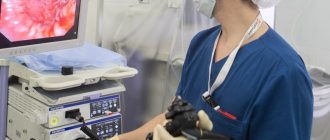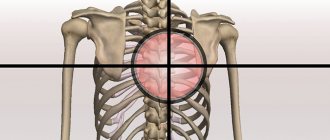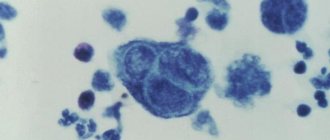Study of femoflora. Indications and preparation
A unique, high-precision method of clinical research using PCR and recording results in real time.
The results obtained from femoflor help to most accurately identify and also specify the quantitative and qualitative characteristics of beneficial and pathogenic bacilli that live and multiply in the urogenital tract of a woman. The analysis makes it possible to find out the activity and concentration of these microorganisms, which will make it possible to develop an adequate treatment strategy, monitor and adjust the effectiveness of therapy.
Research Femoflor Screen (Femoflor-13)
Should be performed when:
- signs of infection: vaginal discharge (yellow, yellowish-white, profuse leucorrhoea, greenish), pain when urinating, discharge between menstruation, pain in the lower abdomen, perineum, discomfort, burning, itching in the external genital area, in the vagina ,
- identifying inflammatory changes in the intimate area (vulvovaginitis, cervicitis, nonspecific vaginitis, etc.),
- detection of predominantly sexually transmitted infections (STIs),
- assessing the state of the microflora of intimate organs in women after treatment,
- the need to clarify the cause of gynecological diseases using a high-precision PCR method when detecting chlamydia, gonococcus, trichomonas in smears,
- casual sexual intercourse without using a barrier method of contraception (condom) or its improper use,
- change of sexual partner,
- a woman’s desire to exclude infections that are predominantly sexually transmitted.
The procedure for taking a vaginal smear for PCR testing is usually recommended before menstruation or 2-3 days after its end.
Decoding
When collecting biomaterial, scrapings are performed from the urethra, vagina and cervical canal. The reliability of the diagnosis directly depends on the quality and volume of samples. Manipulations are performed with sterile, disposable instruments, which guarantees the safety and purity of the result.
The material is delivered to the laboratory in a specially prepared test tube, which contains a medium that preserves the biological properties of the transferred microflora. The decoding of femoflora itself is carried out on the day of the visit to the doctor, the necessary medications are prescribed immediately. You can also figure out the result yourself; the form will indicate the norm and your values.
Study of the biocenosis of the urogenital tract in women (Femoflor-16)
What is Femoflor?
Femoflor is a unique technology based on the use of polymerase chain reaction (PCR) in real time. This technology today allows us to give the most complete quantitative and qualitative characteristics of the normal and opportunistic flora of the urogenital tract in women. Femoflor makes it possible to study difficult-to-cultivate anaerobic microorganisms and at the same time has high sensitivity and specificity.
What is biocenosis?
Biocenosis (from the Greek βίος - “life” and κοινός - “general”) is a collection of different types of microorganisms interconnected by certain relationships and inhabiting a certain biological niche. In the case of vaginal biocenosis, the biological niche for microorganisms is the vagina. The vaginal microflora in women of childbearing age is a well-balanced, stable system and can include more than a hundred species of different bacterial microorganisms, the main of which are lactobacilli, which constitute the normal microflora. Lactobacilli produce hydrogen peroxide and lactic acid, which reduces the vaginal pH to 4.0-4.5. The acid reaction is favorable for the growth and reproduction of lactobacilli, but not other microorganisms. It is known that lactic acid bacteria stimulate local immunity. Due to these factors, lactobacilli protect the woman’s genitourinary system, prevent the colonization of the vagina by pathogenic microorganisms and the excessive proliferation of opportunistic bacteria.
In addition to lactobacilli, other microorganisms (gardnerella, yeast-like fungi, streptococci, staphylococci and others) may be present in the vagina in small quantities. The composition of microorganisms inhabiting the female body, including the genitourinary system, is unique for each woman and depends not only on age, but also on lifestyle. Knowing the characteristics of the composition of microorganisms, you can notice even small deviations in time and, even before the appearance of unpleasant symptoms, correct them with minimal effort, preventing the development of the disease.
It is important that the vaginal biocenosis is involved in ensuring a woman’s reproductive function, protecting her from possible infectious processes.
An imbalance between normal microflora and opportunistic microorganisms leads to the development of dysbiosis. Dysbiotic disorders cause a number of problems - from minor discomfort, a decrease in a woman’s quality of life to serious reproductive problems. There are many reasons for the development of dysbiotic processes in the vagina:
- changes and disturbances in hormonal levels (irregular sex life, pregnancy, childbirth, abortion, any type of cycle disorders, puberty, menopause, use of hormonal contraceptives and medications);
- use of intrauterine devices;
- promiscuous sex life (neglect of barrier contraception, frequent change of sexual partner);
- infections of the genital organs (infectious and inflammatory diseases of the pelvic organs, sexually transmitted infections);
- taking antibiotics (long-term or repeated courses);
- intestinal diseases (chronic problems with stool, intestinal dysbiosis);
- violation of personal hygiene rules (improper use of tampons creates favorable conditions for the growth of bacteria, frequent douching, use of cosmetic detergents for intimate hygiene, wearing tight synthetic underwear);
- decreased general and local immunity;
- hypothermia of the body; unbalanced diet (lack of vitamins and microelements);
- stress and overwork;
- change of climate zone.
Why is the research being conducted?
The study is carried out to determine the presence, degree and nature of microflora imbalance. Which, in turn, is extremely important for the clinician when choosing treatment tactics and for monitoring the effectiveness of the treatment.
To whom and when is this study indicated?
This study is carried out:
- if you are bothered by unpleasant symptoms (itching, burning, discharge, discomfort in the genital area);
- before planned surgical intervention in the pelvic area;
- if there is a feeling of discomfort after taking hormonal drugs, antibiotics;
- infertility;
- miscarriage;
- pregnancy planning;
- preparation for in vitro fertilization
- with ineffective treatment, with unclear results of other laboratory diagnostic methods.
It is important to understand that microflora imbalances that affect your quality of life are not only inconvenient, but can also lead to problems. Timely diagnosis will help identify even minor violations. Therefore, if you experience the slightest discomfort, you don’t have to wait long and don’t put off visiting a doctor.
Where to take a smear for microflora Femoflor-16
take a smear for the Femoflor-16 microflora in Minsk, Baranovichi, Bobruisk, Borisov, Brest, Vitebsk, Gantsevichi, Gomel, Grodno, Zhlobin, Lida, Mogilev, Mozyr, Molodechno, Novogrudok, Novopolotsk, Orsha, Pinsk, Polotsk, Rechitsa, Svetlogorsk , Slutsk, Smorgon, Soligorsk.
Benefits of technology
- High accuracy regardless of the types and numbers of microorganisms.
- The manipulation is safe, does not take much time, and the results will be ready within 24 hours after collecting the biomaterial.
- Clarification of the quantitative and qualitative characteristics of the microflora guarantees the unhindered elimination of infectious and inflammatory processes of the reproductive organs by prescribing the correct treatment.
- Allows you to identify and classify diseases that progress asymptomatically, which means they gradually reduce a girl’s reproductive capabilities.
- Helps to monitor the dynamics of recovery, timely assess the effectiveness of therapy, and, if necessary, correctly adjust the course of treatment.
Test "Androflor"
The Androflor analysis allows one-time quantitative assessment of the state of the microflora of the genitourinary system in men, identifying hidden infections, accurately identifying the causative agent of inflammatory processes in prostatitis, urethritis, epididymitis, and also tracking the effectiveness of the therapy in order to adjust the treatment prescribed by the doctor.
Biomaterial for analysis is taken from possible locations of the pathogen. For example, in case of urethritis, a scraping is made from the urethra, and urine must also be provided. To identify the causes of prostatitis, male infertility, with pathological spermogram results and monitoring the treatment of inflammatory diseases, it is necessary to submit ejaculate (sperm), prostate secretion and scraping from the urethra for research.
When is analysis vital?
A change in the normal environment in the vagina due to the death of its flora, which means the prosperity of yeast fungi, staphylococci, streptococci and other pathogens, has an extremely negative impact on health.
A highly sensitive study of femofloras allows you to quickly, and most importantly, absolutely accurately determine the severity of the situation and take adequate measures to eliminate the problem.
Gynecologists recommend undergoing an examination in the following situations:
- Infertility or miscarriages at various stages.
- During the period of preparation for surgery.
- Menopause and flora disorders with atrophic vaginitis.
- Itching, unnatural discharge, discomfort during urination and sex.
- With a sharp change in hormonal status due to uncontrolled use of oral or vaginal contraceptives.
- Inflammatory processes that reoccur due to a critical disturbance in the biotic balance.
Femoflor-16 study
Should be performed when:
- the presence of symptoms of inflammation or infection in a woman, or the presence of laboratory signs of an inflammatory process (“bad smear”).
- planned operations on the pelvic organs (curettage, hysteroscopy, vacuum, laparoscopy),
- installation of intrauterine devices,
- the presence of a burdened obstetric history (miscarriage, fetal loss at any stage, infertility, termination of pregnancy),
- chronic inflammation, which takes a long time to treat and cannot be cured,
- pregnancy planning, incl. using high reproductive technologies (IVF, ICSI, etc.),
- determining the effect of the treatment, restoring normal vaginal microflora after treatment,
- desire to be examined and get a clear and detailed answer to the question about the condition of the intimate organs (I haven’t been examined for a long time, nothing worries me, but I want to know for sure),
- the presence of leukocytosis (increased white blood cells) in the smear on the degree of vaginal cleanliness (microscopy of the vaginal smear).
Femoflor Screen ((Femoflor-13)) also provides information about qualitative and quantitative changes in the microflora of a woman’s intimate organs. The test detects pathogens - gardnerella, fungi, ureaplasma, mycoplasma, trichomonas, gonococci, chlamydia, genital herpes virus and cytomegalovirus. This research method is highly accurate and important in identifying infectious diseases.
Preparation
Before taking the femoflora test, the doctor introduces the patient to the intricacies and rules of the procedure. Proper preparation will help you get the most reliable results. Tests should be taken at any period of the menstrual cycle, except for menstruation itself.
You should avoid antibiotics and intravaginal products, and 5 days before the test, avoid sexual intercourse and douching. At your first visit to the doctor, all the details of the preparatory process need to be clarified in as much detail as possible; there may be some deviations based on individual characteristics.
general characteristics
Bacterial vaginosis
(BV) is an infectious non-inflammatory syndrome, which is characterized by a high concentration of obligate and facultative anaerobic opportunistic microorganisms with a decrease/absence of lactic acid, primarily peroxide-producing bacteria in the vaginal discharge. The pathogenesis of the development of bacterial vaginosis is due to two interrelated and interdependent processes: alkalization of vaginal contents and a decrease in the concentration of lactobacilli. Diagnosis of bacterial vaginosis (quantitative) - 8 indicators - quantitative determination of the composition of the vaginal microflora: facultative anaerobic microorganisms: Lactobacillus spp., Enterobacterium spp., Streptococcus spp.; obligate anaerobic microorganisms: Gardnerella vaginalis/Prevotella bivia/Porphyromonas spp., Eubacterium spp.; mycoplasmas: Mycoplasma hominis/Mycoplasma genitalium; mushrooms: Candida spp. PCR method









